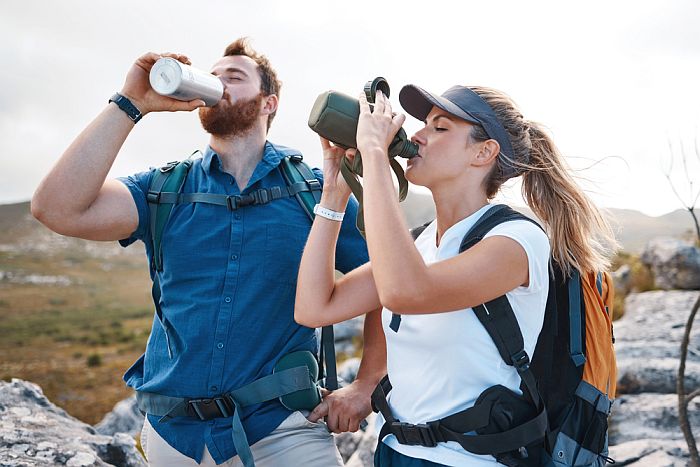If there’s one thing that wrecks more hikes than blisters, bears, and bad decisions combined, it’s dehydration. Most people don’t drink enough water while hiking — and they don’t realize it until their head starts pounding and their legs feel like wet cement.
This page may contain affiliate links; you can read our full disclosure.
So how much water do you actually need on a hike? Here’s a straightforward, real-world breakdown used by experienced hikers, outdoor educators, and backcountry rescue teams.
The Basic Rule: 0.5–1 Liter of Water per Hour
Most hikers stay safely hydrated by drinking 0.5 to 1 liter of water per hour.
- Cool weather, easy terrain: ~0.5 liters per hour
- Moderate conditions: ~0.75 liters per hour
- Hot weather or hard terrain: up to 1 liter per hour
By the time you feel thirsty, you’re already behind — especially in dry or high-altitude environments.
What Changes How Much Water You Need?
Temperature
Heat pulls moisture from your body fast. Even mild warmth increases sweat loss.
Trail Difficulty
More exertion equals more water loss. Steep climbs drain you faster than flat ground.
Elevation
Higher altitudes dehydrate you faster because the air is thinner and drier.
Pace
Fast hikers burn through water quicker than slow, steady hikers.
Pack Weight
Heavier loads create more body heat and more sweat.
Individual Physiology
Some people sweat lightly. Others sweat like they’re irrigating farmland. Adjust accordingly.
How Much Water to Bring for Typical Hikes
- Short hikes (1–2 hours): 1–2 liters
- Half-day hikes (3–5 hours): 2–3 liters
- Full-day hikes (6–10 hours): 3–4 liters minimum, plus a refill option
- Multi-day backpacking: Carry enough to safely reach the next water source (usually 2–4 liters)
These estimates assume moderate temperatures. In hot or desert conditions, increase everything.
Hot Weather Hiking: How Much Water You Really Need
On hot days (85°F+), water needs increase dramatically.
- Expect to drink around 1 liter per hour
- Add electrolytes regularly
- Take breaks to cool down
- Watch for early signs of heat exhaustion
In desert environments, many hikers start with 4–6 liters and refill whenever possible.
Why Electrolytes Matter (More Than Most People Think)
Water alone isn’t enough during long or hot hikes. Sweat strips your body of:
- Sodium
- Potassium
- Magnesium
Replacing only water can dilute electrolytes and leave you feeling weak, nauseous, or light-headed.
Useful options include:
- Electrolyte drink mixes
- Electrolyte tablets
- Electrolyte powder packets
Use plain water most of the time and add electrolytes periodically — especially on long or hot hikes.
Best Ways to Carry Water on the Trail
Water bottles: Simple and reliable for short hikes.
Hydration bladders: Let you sip while walking, which helps prevent dehydration without constant stops.
Large-capacity reservoirs: Collapsible containers or wide-mouth reservoirs are ideal for desert or long-distance trips.
Signs You’re Getting Dehydrated
Early signs:
- Dry mouth
- Fatigue
- Irritability
- Headache
- Light dizziness
More serious signs:
- Dark urine
- Muscle cramps
- Rapid heartbeat
- Confusion
If symptoms escalate, stop hiking, rest, hydrate, and cool down immediately.
The Truth About “Clear Pee”
Your urine shouldn’t be crystal clear all day.
- Light yellow: hydrated
- Bright yellow: dehydrated
- Constantly clear: over-hydrating without electrolytes
You want balance — not a daily flush cycle.
Refilling Water on the Trail
If your route crosses reliable water sources, you can carry less water as long as you have purification gear:
- Hiking water filter
- Squeeze filter
- UV water purifier
- Microfilter bottle
- Purification tablets
Never rely on seasonal streams unless you’ve confirmed they’re flowing.
An Easy Way to Calculate Your Personal Hydration Needs
- Fill a bottle with exactly 1 liter.
- Hike for one hour at your normal pace.
- See how much you drank.
- Adjust for heat and terrain.
Most hikers naturally fall into the 0.5–1 liter per hour range.
Conclusion
So how much water do you need while hiking? Usually more than you think — but not so much that you’re hauling unnecessary weight. The 0.5–1 liter per hour rule provides a solid baseline for most conditions.
Adjust for heat, terrain, elevation, and how your body responds. Bring enough water, keep electrolytes handy, and pay attention to early warning signs. Proper hydration keeps your muscles working, your brain sharp, and your hike enjoyable instead of miserable.

